
By Dan Pinnell
-Early American Lighting Collector/Researcher
To purchase EAPG spills, please visit our Spillholder Store HERE.
| In
very basic terms, a spill holder or “Spill” is a vase or other vessel used before the widespread availability of friction matches to hold the device which transferred a flame. We take matches for granted today, but that was not the case in 1850. Matches first surfaced in England in the 1820s but they were too few and too expensive for common usage & they were only available to a few in the US. There were match manufacturers in Massachusetts and Philadelphia prior to 1860 but if they were used in the mainstream it was purely regional. |
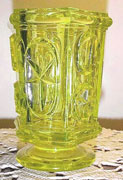 Canary Star & Punty Spill holder ca 1850s & 60s. |
| To light a fire
in their fireplace, most people used splints, spills or tapers even
if they could get matches. A splint, or sliver of wood, was cheap and always on hand cut from a larger piece using a knife or a spill-plane, although spill planes were not marketed as such until late in the 19th century. A spill is a twist of paper, sliver of wood, or spiral of wood shaving. The paper being more objectionable. An early 19th writing suggests the paper burned too quickly and ash flew about the house making a most disagreeable mess. A taper is a very thin candle-like item with a tiny wick center. |
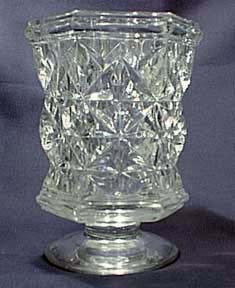 The popular SANDWICH STAR pattern. |
The earliest literary references to splints, spills and tapers date back to the 15th century, as do the vases that held them. The glass "spill holder" period is mostly limited to the 1840s and 50s. An abundance of early writings and paintings clearly depict a holder on the mantle with spills sticking out. Some suggest there is no article called a spill holder because no known advertisement, publication, or bill head depicts them as such. Even the early inventories from the 17th to the 19th century list the items on or near a mantle (where a spill holder should be found) simply as mantle vases, mantle |
glasses
(other than mirrors), or mantle-piece furniture. It may have been
too insignificant
of an article to identify specifically. It was important
at that time to own a holder for spills, but not necessarily one
made of glass. From 1700-1870 spill holders were made of wood, iron,
earthenware,
glass, and even wall paper. The nomenclature depended on what the
purchaser intended when they bought it and roughly what year. From
1860-65 was a huge transitional period in the evolution of lighting
and accessories. |
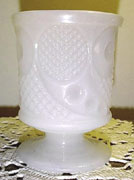 Clambroth Horn of Plenty Spill Holder. A rare color in a popular pattern of 1850s and 60s. |
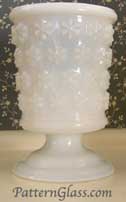 A Boston Sandwich Snowflake pattern spill in rare opalescent. |
tastes,
the emergence of large EAPG table sets, the discovery of vast reserves
of kerosene in western Pennsylvania, the new look of glass lighting
devices and the increased availability and dropping price of the friction
match. Contrary to current popular tales, the word spill has no reference to sopping up spilled oil from lamps. For one thing spills predate lamps and "spill" is a derivative of the word "spile" which means a small piece of wood. It is known that spills/spooners (flint era) were made in many of the same patterns that lamps were made in, not necessarily to match a set of dishes but simply an expediency on the |
| part
of manufacturers
as a way to use a mold twice. No less than thirty patterns are
known to be represented in spill holder/lamp combinations. The late 1850s saw the genesis of the table set (usually three or four companion pieces). This, and changing tastes, ultimately lead to a redesignation of the spill holder to a spoon holder. It would be a mistake to label any one piece of old flint glass as only a “spill” or only a “spooner” because 150 years ago, |
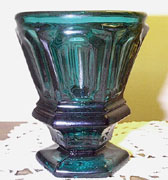 Very early spill in a rare deep green color. |
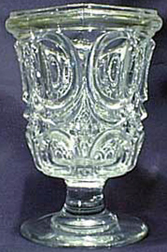 This Spill is BULLSEYE VARIANT and has some of the original 150 year old gold trim at the top edge. |
as
now, people would use glass for whatever their need. Imagine historians
in the year 2150 arguing over whether or not 1990’s glasses were
made for drinking from or for holding toothbrushes! So in many early EAPG shapes, names defined uses which changed over the years and from household to household. The 1859/60 McKee catalog has a drawing of a classic spillholder in the HARP pattern and it is entitled “spoon holder”. As to the Horn of Plenty spill/spooner, that form in that |
| particular pattern is both a spill holder and a spooner.
Toy spills (or spooners) were made in Sandwich along with toy tumblers,
lemonades, tureens, etc. The author owns spills in 26 patterns, has identified another 11, and suspects there may be in excess of 50 patterns. |
 The SAWTOOTH pattern footed salt & spill holder / spooner in milk white. |
for sharing his wealth of information with us.
On the right is a picture of a small plane and some wood spills such as those mentioned in this story might have looked like. |
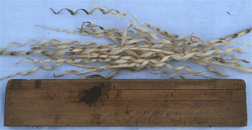 |
 |
.

